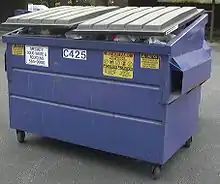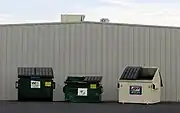Dumpster
A dumpster is a movable waste container designed to be brought and taken away by a special collection vehicle, or to a bin that a specially designed garbage truck lifts, empties into its hopper, and lowers, on the spot.[1][2] The word is a generic trademark of Dumpster, an American brand name for a specific design. Generic usage of skip, or wheelie bin may be used in other English speaking countries.[3][4]

History

The word "dumpster", first used commercially in 1936,[5] came from the Dempster-Dumpster system of mechanically loading the contents of standardized containers onto garbage trucks, which was patented by Dempster Brothers in 1935.[6][7] The containers were called Dumpsters, a blending of the company's name with the word dump. The Dempster Dumpmaster, which became the first successful front-loading garbage truck that used this system, popularized the word.
The word dumpster has had at least three trademarks associated with it by Dempster Brothers,[8][9][10] but today it is often used as a genericized trademark. All three trademarks have since either been expired or cancelled.[11]
A dumpster is sometimes considered synonymous with a skip.[4] However, there are functional differences between them. A skip is intended to be loaded onto a vehicle and transported to another location. Dumpsters, on the other hand, have their contents emptied into a special vehicle, and are seldom moved from their locations.[12]
Function
The main purpose of a dumpster is to store garbage until it is emptied by a garbage truck for disposal.[12] Dumpsters can be used for all kinds of waste, or for recycling purposes.
Most dumpsters are emptied by front-loading garbage trucks. These trucks have large prongs on the front which are aligned and inserted into arms or slots on the dumpster. Hydraulics lift the prongs and the dumpster, eventually flipping the dumpster upside-down and emptying its contents into the garbage truck's hopper (storage compartment). Other dumpsters are smaller and are emptied by rear-loading trucks. Dumpsters are typically emptied outside of peak traffic hours.[12] The frequency at which dumpsters are emptied varies from community to community, often ranging from daily to weekly, depending on the volume of trash generated.[13]
Types
Many businesses, apartment buildings, schools, offices, and industrial sites have one or more dumpsters, generally ranging from 0.5 to 8 cubic yards (0.38 to 6.12 m3), to store the waste that they generate.[14]
Waste storage containers can be made from a wide variety of materials, including steel and fiberglass.[14] Plastic dumpsters became available in the 1970s.[15]
In the United States, 96-US-gallon (0.36 m3) dumpsters (also known as "roll carts" or "toters") are used by small businesses and homes where a normal bin would be too small, but a regular dumpster would be too large. These are emptied by rear-loading trucks or by side-loading trucks purpose-built for emptying roll carts of this and smaller sizes.[16]
Roll-offs, sometimes called roll-off dumpsters or containers or open-top dumpsters or containers, are larger dumpster trailers ranging from 10 to 45 cubic yards (7.6 to 34.4 m3) and are used at demolition sites, clean-outs, renovations, construction sites, factories, and large businesses. These containers are normally carried by very large trucks with hydraulic arms which load and unload the containers with ease, thus allowing these trucks to place these containers in a relatively unobtrusive position.
Roll-off dumpsters are available in a variety of sizes to fit different situations. The size needed will generally depend on three factors: volume of material, type of material, and location or placement of the dumpster. For example, heavy materials like bricks or stones should be placed in smaller dumpsters so the loaded container does not exceed weight limits for transportation.
Dumpster diving
Dumpster diving involves persons voluntarily climbing into a dumpster to find valuables, such as discarded metal scrap, or simply useful items, including food and used clothing. It can also be a method of investigation (e.g., looking for discarded financial records, private papers, or evidence of a crime). Going through garbage containers that are not strictly speaking dumpsters is nevertheless often referred to as dumpster diving.
Gallery
 Three dumpsters in various sizes
Three dumpsters in various sizes Colorful dumpsters painted with slogans
Colorful dumpsters painted with slogans
See also
References
- "Dumpster Meaning in the Cambridge English Dictionary". dictionary.cambridge.org. Retrieved 29 August 2017.
- "the definition of dumpster". Dictionary.com. Dictionary.com, LLC.
- Stevenson, A. (2010). Oxford Dictionary of English. Oxford Dictionary of English. OUP Oxford. p. 544. ISBN 978-0-19-957112-3. Retrieved 3 June 2023.
- Ortiz Zezzatti, C.A.O. (2012). Logistics Management and Optimization through Hybrid Artificial Intelligence Systems. Premier Reference Source. Information Science Reference. p. 51. ISBN 978-1-4666-0298-4. Retrieved 3 June 2023.
- "Dumpster", U.S. Patent & Trademark Office, trademark registration 0743745, filed Feb. 6, 1962, registered Jan. 15, 1963.
- Dempster, George R. "US Patent #2150821". Google Patents. Retrieved 20 November 2010.
- "Beginnings: The Dempster Dumpster". Classic Refuse Trucks DEMPSTER. 6 January 2006. Archived from the original on 20 February 2011. Retrieved 20 November 2010.
- U.S. Trademark 71,662,015
- U.S. Trademark 72,137,327
- U.S. Trademark 72,196,260
- "dumpster trademarks – Justia Trademarks". trademarks.justia.com. Retrieved 2018-02-17.
- Chandrappa, R.; Das, D.B. (2012). Solid Waste Management: Principles and Practice. Environmental Science and Engineering. Springer Berlin Heidelberg. pp. 67–70. ISBN 978-3-642-28681-0. Retrieved 3 June 2023.
- Stevens, B.J. (1980). Handbook of Municipal Waste Management Systems: Planning and Practice. Environmental Engineering Series. Van Nostrand Reinhold. pp. 29, 23, 103. ISBN 978-0-442-23362-4. Retrieved 3 June 2023.
- Sinclair, L.A.; Technology & Development Program (U.S.) (1999). Comprehensive Waste Management (in German). USDA Forest Service, San Dimas Technology & Development Center. p. 7. Retrieved 3 June 2023.
- Stokes, R.G.; Köster, R.; Sambrook, S.C. (2013). The Business of Waste: Great Britain and Germany, 1945 to the Present. Cambridge University Press. p. 210. ISBN 978-1-107-02721-3. Retrieved 3 June 2023.
- "Document Display - US EPA". NEPIS. 12 September 2008. Retrieved 3 June 2023.